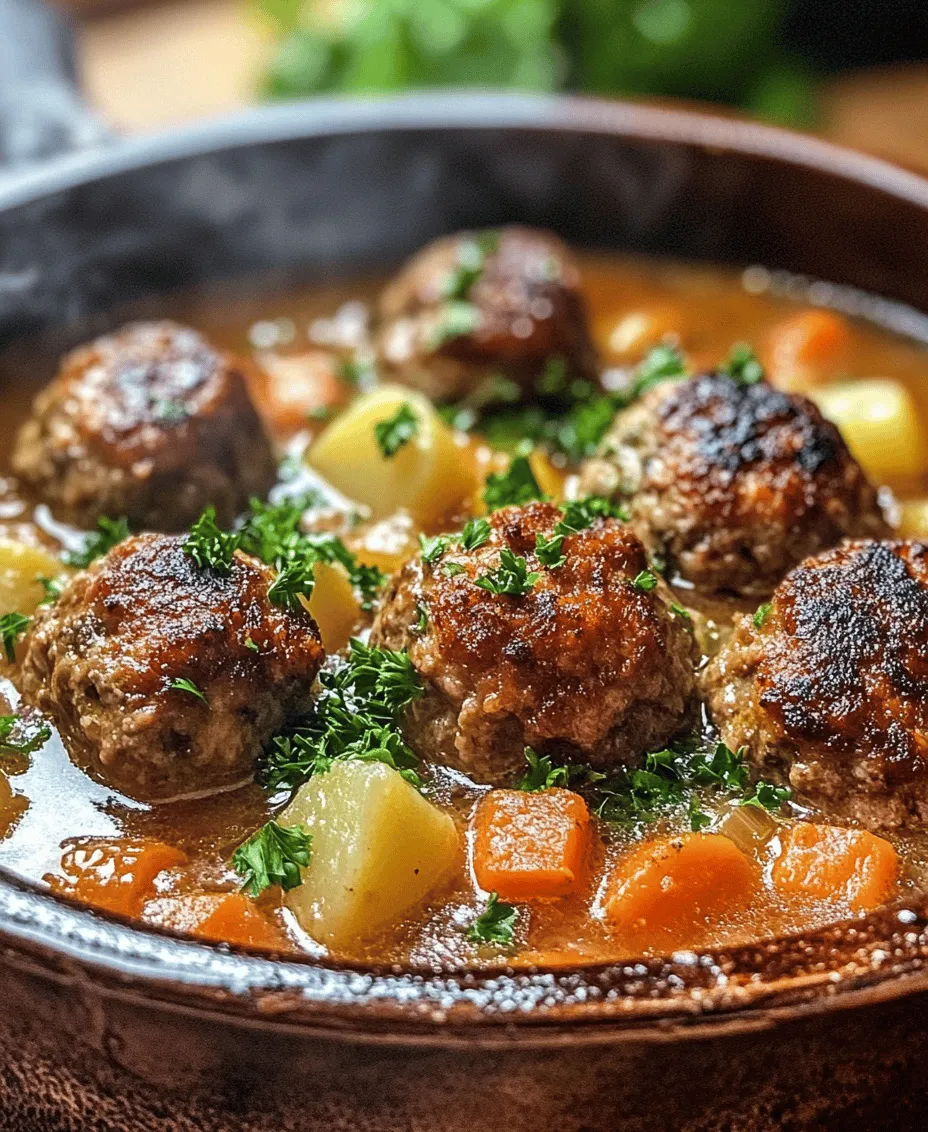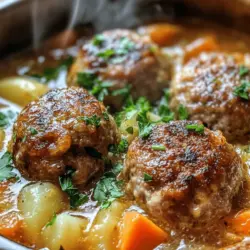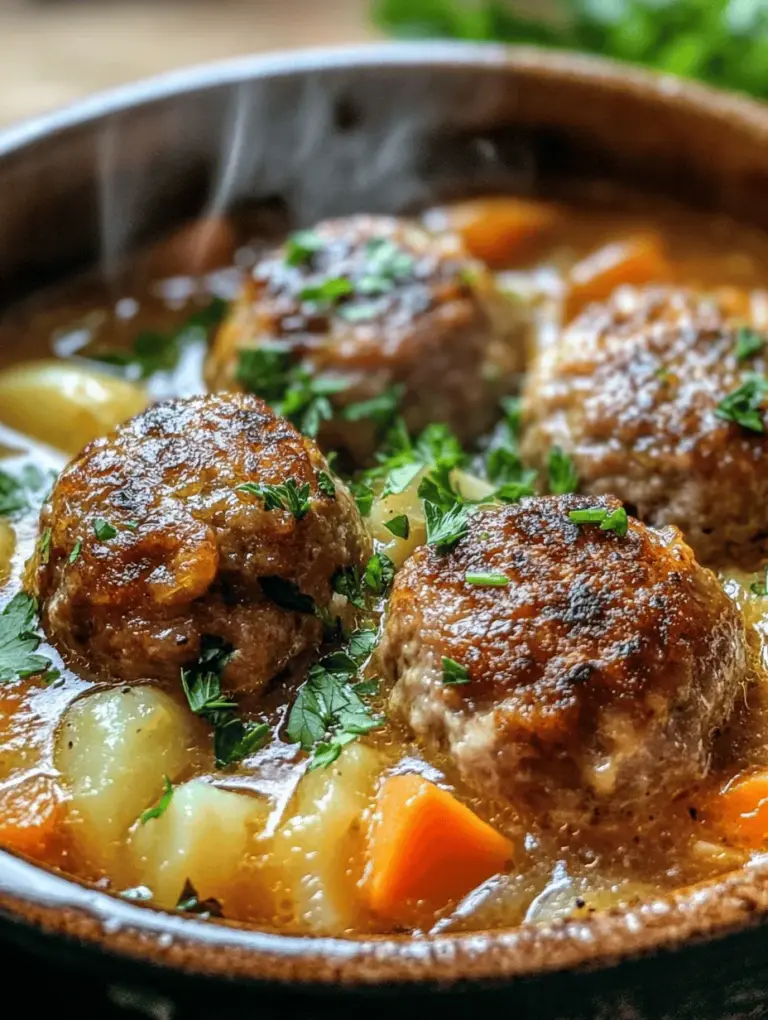Introduction
As the leaves turn crisp and the air grows cooler, there’s nothing quite like the comforting aroma of a hearty meatball stew wafting through the kitchen. This classic dish is not just a meal; it’s an experience that brings warmth and satisfaction with every spoonful. Hearty meatball stew is a culinary hug, making it the perfect choice for family gatherings, cozy weeknight dinners, or any time you crave a filling, flavorful dish that nourishes both body and soul.
This recipe combines the rich, robust flavors of Italian cuisine with wholesome, accessible ingredients, making it a versatile option for any season. Whether you’re serving it on a chilly winter evening or a relaxed fall afternoon, this stew promises to satisfy and delight. With tender meatballs simmered in a savory broth packed with vegetables, every bite tells a story of comfort and togetherness—a true testament to the power of home-cooked meals.
The Comfort of Hearty Meatball Stew
Throughout history, meatball stew has held a prominent place in many cultures, from Italian kitchens to Eastern European families. The stew is more than just a dish; it is a tradition that has been passed down through generations, often made with whatever ingredients were available, showcasing the adaptability and resourcefulness of home cooks.
Stews, in general, have been a staple in households around the world due to their ability to serve multiple people with ease. They allow for creativity in the kitchen, where cooks can mix and match ingredients based on personal preferences and seasonal produce. The comforting nature of a bubbling pot of stew has a remarkable power to bring families together, fostering connections over shared meals and stories.
In this recipe, we’ll explore the beautiful marriage of meatballs and vegetables enveloped in a rich broth, creating a dish that is both hearty and nutritious. By combining classic Italian flavors with modern cooking techniques, this meatball stew is destined to become a favorite in your home.
Ingredients Breakdown
The Foundation: Meatballs
The heart of any meatball stew lies in the meatballs themselves. Crafting the perfect meatballs requires a careful balance of flavors and textures. For this recipe, you will need:
– Ground Meat: A blend of ground beef and pork provides a rich flavor and moist texture. The beef adds depth, while the pork contributes tenderness. If you prefer a leaner option, you can use ground turkey or chicken, but for the most authentic taste, stick with the traditional meats.
– Breadcrumbs: These act as a binder, helping the meatballs hold their shape during cooking. Fresh breadcrumbs are preferable, as they provide a lighter texture compared to dried. If you’re looking for a gluten-free option, substitute with ground oats or gluten-free breadcrumbs.
– Parmesan Cheese: This ingredient enhances the flavor profile of the meatballs, adding a salty, nutty essence that enriches the stew. Opt for freshly grated Parmesan for the best results.
– Egg: The egg serves as another binding agent, ensuring your meatballs stay together and remain moist throughout the cooking process.
– Herbs and Spices: Fresh parsley, garlic powder, salt, and black pepper are essential for seasoning the meat mixture. You can also add a dash of Italian seasoning for an extra punch of flavor.
Each ingredient plays a pivotal role in achieving the ideal meatball—tender, flavorful, and able to withstand the simmering process without falling apart.
The Flavor Makers: Aromatics and Seasoning
Aromatics are the unsung heroes of any stew, and this meatball stew is no exception. The inclusion of the following ingredients will elevate the dish’s flavor profile:
– Garlic: Fresh garlic brings a robust flavor that complements the meatballs beautifully. It infuses the stew with a fragrant aroma that enhances the overall taste.
– Onion: Sautéed until translucent, onions add sweetness and depth to the stew. They provide a solid foundation for the flavor base, allowing the other ingredients to shine.
– Carrots and Celery: These classic mirepoix vegetables add texture and natural sweetness. They also contribute to the nutritional value of the stew, making it more wholesome.
– Italian Seasoning: A blend of dried herbs such as oregano, basil, and thyme, Italian seasoning imparts an authentic flavor reminiscent of traditional Italian cooking. Its inclusion in the recipe ties all the elements together, creating a harmonious balance.
– Worcestershire Sauce: This sauce adds a complex umami flavor that enhances the overall taste of the stew. A small amount goes a long way in enriching the broth.
The Liquid Gold: Broth and Tomatoes
The base of any great stew is the liquid that binds everything together. For this hearty meatball stew, you will need:
– Beef Broth: This ingredient is essential for creating a rich and flavorful stew. Homemade beef broth is ideal, but store-bought options work just as well. Look for low-sodium varieties to control the saltiness of your dish.
– Diced Tomatoes: Canned diced tomatoes add acidity and sweetness, balancing the richness of the meatballs. They also contribute to the stew’s beautiful color and texture. For an extra layer of flavor, consider using fire-roasted diced tomatoes.
These ingredients not only provide moisture but also create the delicious, savory broth that makes the stew so comforting. The combination of beef broth and tomatoes results in a deep, rich flavor that permeates every bite.
Step-by-Step Guide to Making Hearty Meatball Stew
Preparing the Meatballs
Now that we have gathered our ingredients, it’s time to start preparing the meatballs. Follow these steps for a successful outcome:
1. Mix the Ingredients: In a large mixing bowl, combine the ground meat, breadcrumbs, grated Parmesan cheese, egg, minced garlic, chopped parsley, salt, and pepper. It’s best to use your hands for this process; however, ensure they are clean and dry to avoid a sticky mess.
2. Achieve the Right Consistency: Mix the ingredients gently until just combined. Overmixing can lead to tough meatballs, so be careful not to work the meat too much.
3. Form the Meatballs: Once your mixture is well combined, use your hands to form small balls, about 1 to 1.5 inches in diameter. Aim for uniformity in size so that they cook evenly. If the mixture feels too wet, you can add a bit more breadcrumbs to achieve the desired texture.
4. Chill (Optional): For meatballs that hold their shape better, consider chilling them in the refrigerator for about 30 minutes before cooking. This step helps firm them up, making them less likely to fall apart during cooking.
Browning the Meatballs
Next, we’ll brown the meatballs to enhance their flavor before they simmer in the stew. Here’s how to do it:
1. Heat the Oil: In a large, heavy-bottomed pot or Dutch oven, heat a couple of tablespoons of olive oil over medium-high heat. The oil should be hot enough that it shimmers but not smoking.
2. Brown the Meatballs: Carefully add the meatballs to the pot without overcrowding. You may need to do this in batches. Allow them to brown on all sides for about 5-7 minutes. This step is crucial, as it develops a deep, savory crust that adds complexity to the stew.
3. Remove and Set Aside: Once the meatballs are browned, transfer them to a plate and set them aside. Don’t worry if they’re not cooked through; they’ll finish cooking in the stew later.
The browning process not only enhances the flavor of the meatballs but also adds depth to the overall dish. The delicious fond left at the bottom of the pot will be incorporated into the stew, enriching the broth with even more flavor.
As we continue to build this hearty meatball stew, each step brings us closer to a meal that embodies the essence of comfort food. With the meatballs prepared and browned, we are ready to move forward with the next stages of this delightful recipe. Stay tuned for the next part, where we will assemble the stew and let it simmer to perfection.

Browning the Meatballs: The Key to Flavor
Browning the meatballs in olive oil is a crucial step in the preparation of your hearty meatball stew. This technique not only adds a beautiful color to the meatballs but also enhances their flavor significantly through the Maillard reaction. When meat is browned, complex chemical reactions occur between amino acids and sugars, resulting in a depth of flavor that raw or boiled meat simply cannot achieve.
To achieve a perfect sear, it’s essential to follow a few best practices. First, make sure your meatballs are evenly sized, allowing for consistent cooking. Preheat your skillet over medium-high heat and add enough olive oil to coat the bottom. Once the oil shimmers, add the meatballs, ensuring not to overcrowd the pan; this allows them to brown properly rather than steam. Sear the meatballs for about 3-4 minutes on each side until they are golden brown. Once done, transfer them to a plate and set aside, retaining the rendered fat in the pan to sauté your vegetables.
Sautéing the Vegetables
The next step involves sautéing the vegetables, which is paramount for developing layers of flavor in your stew. Start by adding onions, garlic, and any other vegetables you desire, such as carrots or bell peppers, to the same pan you used for the meatballs. The residual fat will impart a rich flavor to the vegetables, while the caramelization that occurs will further enhance the taste.
Sauté the onions until they are translucent, about 5 minutes, then add garlic and cook for an additional minute to avoid burning. It’s important to monitor the cooking time closely; you want the vegetables to be tender yet maintain some texture. This process should take about 8-10 minutes total. The goal is to create a flavorful base for your stew that will harmonize with the meatballs and broth.
Building the Stew Base
After the vegetables are perfectly sautéed, it’s time to build the stew base. Start by pouring in your choice of broth—beef, chicken, or vegetable broth works beautifully. The broth not only adds liquid but also enriches the stew with flavor. Next, introduce crushed tomatoes or diced tomatoes to the mix; their acidity balances the richness of the meat and enhances the overall depth of flavor.
Bring the mixture to a gentle simmer, which is crucial for allowing the flavors to meld together. This phase of cooking is where the magic happens—let it simmer for about 10 minutes. During this time, the ingredients will infuse each other, creating a luscious, hearty base for your stew.
Combining Ingredients for a Hearty Finish
Once your broth and vegetables are simmering, it’s time to combine the meatballs and potatoes into the pot. Gently place the browned meatballs back into the stew, along with diced potatoes. Potatoes not only add substance but also soak up the flavors of the broth, making every bite satisfying.
Season the stew with salt, pepper, and any additional herbs like thyme or bay leaves for extra flavor. Allow the stew to simmer for an additional 20-25 minutes, or until the potatoes are fork-tender. This step is crucial; it ensures the meatballs absorb the flavors of the stew while the potatoes cook to the perfect tenderness.
Serving Suggestions
When it comes to serving your hearty meatball stew, the presentation can elevate the dining experience. Ladle generous portions into bowls and consider serving with crusty bread for dipping. Alternatively, a fresh side salad can provide a refreshing contrast to the hearty stew.
For a finishing touch, sprinkle freshly chopped parsley over the top. This not only adds a burst of color but also a hint of brightness that complements the rich flavors of the stew.
Nutritional Benefits of Hearty Meatball Stew
Hearty meatball stew is not only delicious but also packed with nutritional benefits. The meatballs provide a solid source of protein, essential for muscle repair and overall health. The array of vegetables contributes vital vitamins and minerals, boosting your immune system and promoting well-being.
Furthermore, potatoes add fiber to the dish, which supports digestive health and helps you feel full longer. This stew can easily fit into a balanced diet, offering a variety of nutrients in a single, satisfying meal.
The Versatility of Meatball Stew
One of the joys of making meatball stew is its versatility. While the classic recipe is undeniably comforting, feel free to experiment with different types of meat. Ground turkey or chicken can create a lighter version, while pork can add a unique flavor profile.
You can also customize the vegetables based on seasonal availability. Incorporating greens like spinach or kale can enhance the nutritional value and add a vibrant color. For those looking to add heartiness, consider incorporating grains such as rice or barley, which can transform the stew into an even more filling meal. These variations allow the recipe to cater to diverse dietary preferences while keeping the essence of a comforting stew intact.
Conclusion
In summary, hearty meatball stew is a nourishing and satisfying dish that can easily become a family favorite. Its rich flavors and comforting texture make it perfect for gatherings or cozy nights at home. The ability to customize the recipe to suit individual tastes—whether by altering the type of meat, adding new vegetables, or including grains—ensures that it remains a versatile option in your culinary repertoire.
The process of creating this stew is not only about following a recipe but also about enjoying the act of cooking and sharing a meal with loved ones. As you gather around the table, savor the warmth and heartiness of this delightful stew, knowing that it has the potential to become a cherished tradition in your home.


